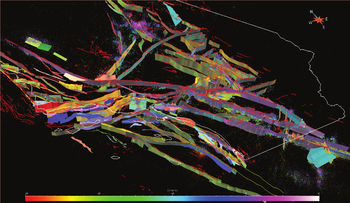Moved:CFM
{{#externalredirect: https://www.scec.org/research/cfm}}
SCEC Community Fault Model (CFM)
CFM Release V5.2
Community Fault Model Version 5.2: Updating & expanding the CFM 3D fault set and its associated fault database
We present an updated version of the SCEC Community Fault Model (CFM) for southern California. For version 5.2, we continue to focus on expanding and improving the database component of CFM that is critical for the internal consistency and maintainability of the model. This hierarchical name and numbering system enables model users to access and assess the full richness of the various fault systems, 3D fault models, and alternative 3D fault representations in CFM. In addition to fault area, fault system, fault section and fault name, the expanded CFM database now includes fields for alternate and CFM version number, source, descriptor, references, USGS Quaternary fault (Qfault) ID, and fault attributes of average strike, dip, area, and faulting style. Care was taken to insure that the database is synchronized with the latest catalog of individual, t-surf CFM fault representations. Through this process, various fault models or components were identified that needed to be added or improved. These models were updated either by developing new alternative 3D fault models or by better regularization of their 3D fault surface meshes. In addition, the database was updated to reflect any changes in the underlying fault geometry, revised fault linkages, or if more suitable locations in the hierarchical naming system were found. For example, the Earthquake Valley, Agua Caliente, Hot Springs, and San Felipe faults are now separated and re-assigned to their respective Agua Tibia-Earthquake Valley and Hot Springs-San Felipe fault zones [e.g., Gordon et al., 2015]. Thus, many new or updated 3D fault representations were added to CFM based on revised, updated USGS/CGS Qfault mapped surface traces and improved relocated seismicity catalogs. New or revised fault models were added in the Sierra Nevada fault area (e.g., Airport Lake) and Coast Ranges fault area (e.g., San Juan, Big Spring, Lockwood Valley, Oceanic, Little Pine), an updated, split Newport-Inglewood fault was developed, and new updated rupture models for the 1812 and 1857 earthquakes and adjacent Transverse Ranges faults related to the Cajon Pass Earthquake Gate Area Initiative were added to CFM. A primary model of preferred CFM-v.5.2 3D faults based on CFM-v.4.0 & UCERF fault rankings and updates by the development team, plus a set of viable alternative representations and an associated, fully populated database spreadsheet are accessible from the SCEC Community Modeling Environment.
Key Words
- 3D fault models, fault database, updated fault set
Citation
- Nicholson, C., Plesch, A., & Shaw, J. H. (2017, 08). Community Fault Model Version 5.2: Updating & expanding the CFM 3D fault set and its associated fault database. Poster Presentation at 2017 SCEC Annual Meeting.
- Submitted August 15, 2017, SCEC Contribution #7735, 2017 SCEC Annual Meeting Poster #TBD
Related Projects & Working Groups
- SCEC Community Models (CXM)
Harvard CFM Web Site
Proposed Development Plan
- Review and refine the DB schema that already has been developed.
- Create a DB with the refined schema
- Import the Excel spreadsheet into the DB
- Develop simple queries to show all CFM information is accessible
- Develop CFM format converters to put tsurf into recilinear, regular grid, and Simulation formats
- Develop GUI interface to DB that shows faults, and enables researchers to retrieve both CFM metadata and CFM fault geometries.
